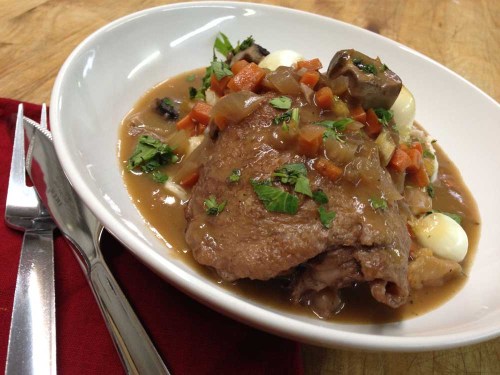Coq au vin and the food of the poor
Published 8:00 pm Friday, October 31, 2014

- Coq a vin, literally translated “rooster in wine,” is a peasant-created dish that makes the most of common ingredients.
Coq au vin, literally “rooster in wine,” is one of those classic French dishes that many of us may have heard of or even tried, but few have attempted to cook. Its closest culinary cousin is chicken cacciatore, so if you’ve prepared that you’ve gotten close.
See, it used to be that everyone had chickens. Most people lived in rural areas away from the trappings of modern life and money. You wanted to eat, you grew it or killed it yourself. So you need to use up all the ingredients you had and you had to make them tasty — there was no corner 7-Eleven to go and grab a snack from. The origins of most of our tried and true “traditional” and “classic” recipes are peasant food.
Why? Because poor people had to figure out how to make $1 feed a family of nine for a week. They couldn’t afford the best cuts of meat, when they could afford meat. They had to settle for the scraps, the chewy bits, the throwaways. And then they had to figure out how to make it tasty.
Think of some of your favorite foods. Now, think about how they are made. Fish and chips was the working class poor’s staple in England. Pasta has sustained the impoverished of China and Italy for hundreds of years. It’s what you could scrape together with what bits and pieces you had and feed your family.
I think 99 percent of the food I love to cook and eat is peasant meals. Those things with humble origins that are put together with care.
Think about it — mac and cheese, the hamburger, and one of my favorite poor foods, ravioli. Ravioli is pasta stuffed with something. Usually a tiny bit of meat and lots of filler. But think about tucking in to a great bowl of ravioli right now … you see? It evokes the memory, because when it’s good, it’s really good.
So it is with all of the “classics” like coq au vin. Where the flavors are deep and layered, not from exotic spices or expensive ingredients but from careful consideration of your items at hand and how best to treat them. And that is the real key here, knowing what to do with it. But fear not, we are here to help and we’ll be guiding you through some of those questions in the weeks to come.
The idea behind coq au vin is simple. You have an old rooster (yes, he’s not a spring chicken anymore) and you need to feed your family …. what to do, what to do. Well, if you try roasting or frying, it’s going to be tough, and probably not too tasty. So you slow cook him in wine and root vegetables and voila! Dinner.
While there are many great recipes out there, I think this one is great and very simple. The key is to take your time and not to reach for the really expensive bottle of wine but rather something simple, rustic and even a little lighter than you might be used to. We have a plethora of great wines available to us in the Walla Walla Valley and Eastern Oregon. We also have some very knowledgeable wine salespeople here, too. Don’t be afraid to ask your wine merchant for some suggestions and if they cannot answer your questions, go somewhere where they can. My suggestion for great coq au vin is a really inexpensive, under $20, French Cotes du Rhone or better yet a burgundian style of either Pinot Noir or Gamay Noir, preferably from Beaujolais and not neuveau.
Coq au vin (Chicken in Wine-French country style)
Please read through the whole recipe once (at least) before attempting so you can understand the whole process.
• Chicken — a whole fryer would be good; I prefer legs and thighs myself as they hold up better with this type of cooking. Say about 2 to 5 lbs depending on the number of people you are serving.
• Olive oil (extra virgin only) for cooking.
• Bacon (or pancetta) 1 lb., chopped into lardoons (matchsticks)
• 1 onion-yellow, medium, rough chop (for step 1)
• 2 carrots, med to large, rough chop (for step 1)
• 3 celery stalks, well cleaned, rough chop (for step 1)
• ½ onion, yellow, med. dice (for Step 2)
• 2 carrots, med to large, med. dice (for Step 2)
• 2 celery stalks, med. dice (for Step 2)
• 1 clove garlic, mashed
• Tomato paste, small can, not seasoned.
• Pearl onions (optional) trimmed of skin, see below.
• Mushrooms 1 lb. (optional) — cremini (brown) small, cut into quarters, stems removed (save stems)
• Salt and pepper and sugar (if needed)
• Chicken stock, preferably homemade, but a good canned one is OK in a pinch. If using canned please follow step 1 otherwise proceed to step 2.
• Wine, something red, something dry, something light, something inexpensive. My first choice is always Gamay (preferably from the Beaujolais region), a lighter Grenache or even a lighter Cotes du Rhone can work. Something with little to no oak as those flavors turn bitter when cooking for this long. See below for some recommendations.
Step 1. In a heavy bottomed pot (like a Dutch oven or enameled cast iron) over medium heat, add olive oil, and onions, carrots and celery. Brown. Once your root vegetables are caramelized, add your canned stock (2 large cans or boxes) and bring to a boil. Once this boils, reduce to a simmer (bubbles just barely breaking the surface) and reduce by 1/3. Once this has reduced thoroughly, strain through a fine mesh strainer and discard vegetables. Set your super stock aside.
Step 2. Set your heavy bottom pot over a med high flame. Once hot add olive oil, add chicken 3 to 4 pieces at a time and brown evenly, in batches until all the chicken is browned on all sides. Remove and set aside. Add bacon to hot pan, brown. Once browned, remove bacon pieces, leave fat, add vegetables for step 2. Gently caramelize. Once the vegetables have begun to brown add garlic. Once garlic is translucent add tomato paste. Cook for two to five minutes until the tomato paste loses that bright red look. Add wine, the whole bottle. Yes, the whole bottle. Reduce the wine for 5 minutes over MEDIUM heat (do NOT set your kitchen on fire!). Add chicken back to pot. Add stock back to pot. Bring this to a boil. Once it begins to boil, reduce heat to LOW and cover. Simmer for 30 minutes to 1 hour. When chicken begins to fall from the bones, you are done. If you are adding the pearl onions and or the mushrooms, do this at the ½ way point, to 15 minutes before it is finished cooking.
You can serve this over egg noodles or boiled potatoes or even just with some good crusty bread as is or you can be fancy and do this: remove chicken, vegetables from liquid and cover with foil. In a separate sauce pan heat 1 stick of butter. Once butter is melted, add 1 cup of flour to make a roux. Cook to blonde to dark blonde stage. Add to liquid in small batches, 1 cup at a time, to desired thickness. Keep your liquid over med low fame during this process, the roux will reach its full thickening power at a boil. If the roux begins to clump, do not worry. You can remove lumps in your sauce by using an immersion blender or you can run your sauce through your blender a bit at a time if you are making ahead.
Taste your sauce. Add salt, pepper or sugar (some wines can be too acidic and/or bitter when cooked) to taste. If your sauce is bitter, add a bit more salt (it will help remove the bitter notes). This is why we are NOT seasoning during cooking. Assemble all ingredients on each plate or bowl , add sauce, sprinkle with bacon and serve. Cheers.
To prepare the pearl onions: Cut an X at one end. Place onions into a pot of boiling water for 30 seconds. Quickly remove to an ice bath. When cool, the skins will slip off. Viola!
Notes on the wine:
Most of the “country” French wines you find in France have little to no new oak used in the process, as barrels are expensive and most “vignerons” cannot afford new oak barrels for their wines every year. There are some really fantastic Beaujolais wines out right now, NOT the neuveau stuff, which is good, but not what you want here. Debeouf is a great producer that is easily found at most supermarkets. There are many wines that he “produces,” the easiest to find are the village wines. These wines are blends from different vineyards and different districts, usually good and inexpensive at $8-$15. Then there are the “cru” wines, from specific districts; Morgon, Julienas, Brouilly, Fleurie and such. These wines offer more structure, more terroir and usually command a higher price tag, $15-$30. I would cook with a good village and drink a cru with this meal. I think it offers the best pairing and at an affordable price.
Several other producers of Beaujolais that are usually easy to find; Louis Jadot, Bouchard Aine et Fils, Trenel, Louis Latour. Your local wine shop would be a good choice to find some nice cru Beaujolais wines as well. Cheers.





